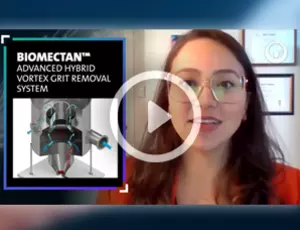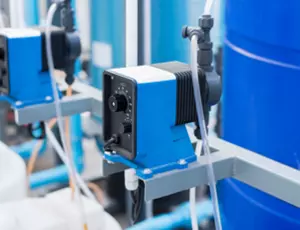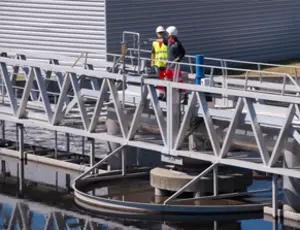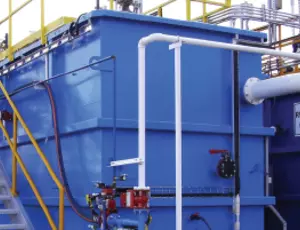Veolia helps clients extend the life and improve the efficiency of their cooling tower systems through an integrated approach of chemicals, equipment and services.
Cooling Tower Water Treatment
Both industrial and commercial operators of cooling tower systems know how critical it is to keep their systems running efficiently and reliably. Cooling tower systems are used to remove heat from both manufacturing and utility processes, which can impact both production efficiency and employee working conditions. A thorough understanding and control of the water used in a cooling system is necessary for optimizing its operation.
Evaporative losses occur during cooling tower operation, and leave behind residual dissolved minerals in the cooling water. When the evaporated water is replenished with fresh make-up water, additional dissolved solids are added and begin to “concentrate” or “cycle up” in the cooling tower. As evaporation continues, the cooling tower cycles of concentration increase, and the cooling tower water becomes less stable. If effective cooling water management practices such as tower blowdown and water treatment chemical control are not managed properly, mineral scale, corrosion and biological fouling will begin to negatively impact the cooling tower energy removal capacity and overall efficiency.
Partner With An Experienced Cooling Tower Water Treatment Company
At Veolia Water Technologies, our trained water treatment representatives work with clients to optimize the operational control parameters of their cooling tower systems and utilize our proprietary line of Hydrex water treatment formulations to provide system-wide protection against the scale, corrosion, fouling and microbiological growth which can rob efficiency and reliability from their cooling systems.
Contact an Expert at Veolia Water Technologies Today
The Importance of Cooling Tower Water Treatment
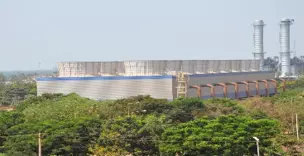
Cooling tower cycles of concentration are controlled by determining the optimal conductivity range for a system. The higher the cooling tower conductivity range, the more cycles of concentration the cooling tower operates at, and the less make-up water is used by the cooling tower system. However, at higher cycles of concentration there is also a greater risk of scale, corrosion and fouling potential. Operators need to work with their water treatment professional to balance cooling tower blowdown control with proper cooling tower chemical treatment, and establish proper control parameters which optimize both water usage and heat exchange efficiency in their cooling tower systems.
Both cooling tower blowdown and the feed of cooling tower chemical treatments are most often controlled through automated systems such as Veolia Water Technologies’ Hydrex™ 5C PLC controller, which maintains cooling water quality within the control parameters necessary to optimize cooling tower performance.
No two cooling tower water treatment programs are alike, due to the number of water quality and operational variables which impact the system’s performance. Starting with the water quality itself, cooling tower operators need to understand the tendencies that their water possesses. Working alongside their water treatment professional, the cooling tower water treatment program should be designed around the water quality of the system and the problems that need to be addressed. Control parameters and a cooling tower chemical treatment program should be developed which neutralize the scaling, corrosive or fouling nature of the cooling water throughout the system and optimize both heat exchanger efficiency and system protection.
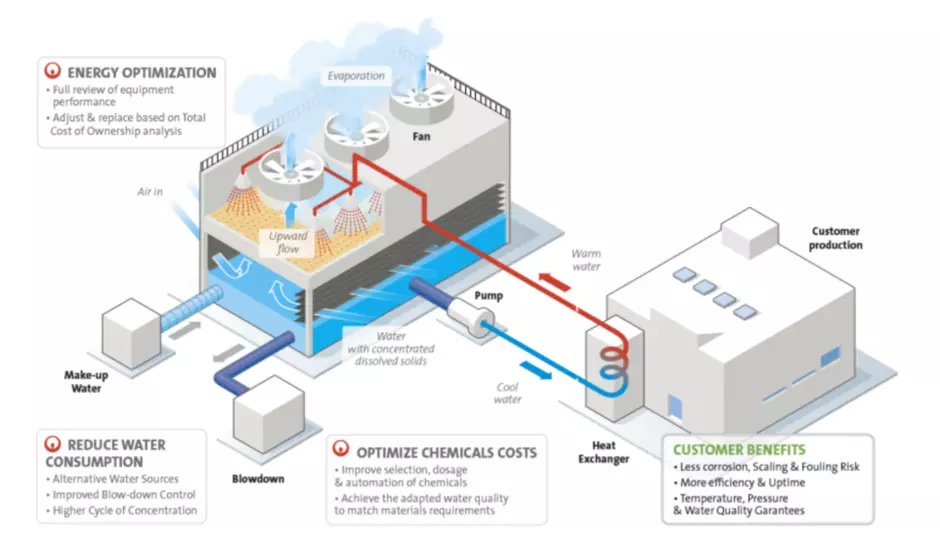
Cooling Tower Deposit Control
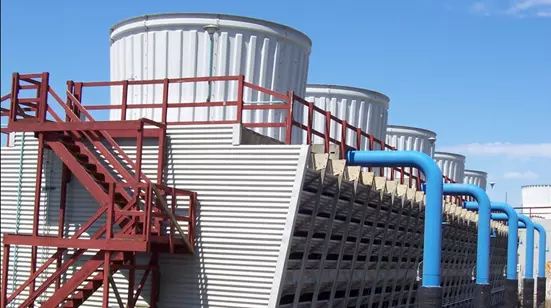
For cooling tower waters that have a scaling potential, HydrexTM deposit control products utilize different blends of polymers, dispersants and surfactants to keep metal heat exchange surfaces clean, thereby allowing for efficient heat rejection by the cooling system. By doing so, Hydrex cooling tower chemical treatments also protect against under-deposit corrosion that can occur in high heat or low flow areas of the cooling system. This type of corrosion will negatively influence heat exchange efficiency, equipment efficiency, and cooling system reliability. Deposit formation can occur through a number of different mechanical and chemical mechanisms, driven by variables such as system temperature, water quality, water velocity, system metallurgy and the length of time the water remains in the system. The higher the temperature and the lower the flow rate, the greater the probability of deposit formation. Such conditions most often occur in heat exchange equipment, but can also be seen in the cooling tower fill itself, where added stresses such as airborne foulants and microbes can form the nucleus of deposits in the fill.
By promoting a well-balanced cooling tower deposit control program, the proper feed and control of Hydrex cooling water chemical treatments can provide cooling tower operators the following benefits:
- Increased cooling water flow
- Optimized heat transfer rates in heat exchange processes
- Reduced water consumption and costs
- Reduced effluent water volumes and wastewater costs
- Protection of the capital equipment utilizing cooling water
About Cooling Tower Corrosion Control
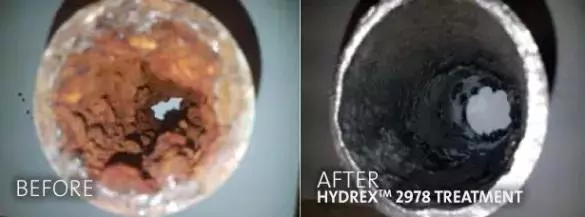
Corrosion occurs in cooling systems by either chemical or electrochemical reactions on the metal surfaces. When corrosion occurs, it creates two very distinct problems that cooling system operators need to react to:
- Equipment Failures occur from the corrosion of key equipment components that impact performance, along with the costs of both replacement (CAPEX) and the downtime OPEX associated with the replacement process.
- Plant Production Efficiency is also negatively impacted due to the loss of heat transfer in equipment where the accumulation of corrosion products on heat exchanger surfaces has occurred.
While there are many different types of corrosion, the majority of cooling system corrosion is created through two specific modes:
Uniform Corrosion - which results in a gradual decomposition of the metal, is the result of oxygen attack (oxidation) at the water/metal interface. Unprotected, this oxidation will progress and appear as a Metal Oxide or a general “rusting” of the system surfaces. While uniform corrosion should be minimized in order to protect system integrity, it is not as aggressive as galvanic corrosion.
Galvanic (Localized) Corrosion - occurs when two different metals are exposed to a corrosive environment, where an electrical potential difference is created. Similar to a car battery, a cathode (positive) and anode (negative) are created. Metal loss will occur at the anode, and quickly accelerate through metal piping or heat exchange surfaces resulting in a visible pitting of the surface. Pitting potential in a cooling tower is accelerated by the use of different metals in contact with each other. For example, copper heat exchanger tubes being rolled into a mild steel tube sheet poses the risk of galvanic corrosion occurring and must be accounted for by system operators and their water treatment professionals.
Common solutions to minimizing cooling tower system corrosion:
- Changing the system metallurgy:
- Highly alloyed metals (typically very expensive) can be used. These metals are very resistant to general corrosion, but are susceptible to other types of more localized corrosion such as stress corrosion cracking.
- Ensure that differential metallurgies are not located near each other during system design, promoting the formation of electrochemical corrosion cells.
- Prevent the corrosive media (water/oxygen) from contacting the metallurgy:
- Coating the metallurgy with a thin protective barrier
- Using the natural calcium and alkalinity in system water to create a protective film of calcium carbonate on the metal surfaces
- Removing the oxygen from the circulating water, either by mechanically or chemically deaerating it.
- Adding corrosion inhibitors to the water
Veolia Water Technologies can assist cooling water owners and operators by developing a Hydrex cooling water treatment program specifically designed to minimize corrosion in their systems. Properly administered and controlled, Hydrex corrosion inhibitors can help minimize metal losses and maintain heat exchange efficiency in your system, as well as prevent any production down-time associated with equipment failures due to corrosion and corrosion byproducts.
Fouling Control
Another threat to cooling system efficiency comes from the presence of both organic and inorganic macrofoulants, such as dirt, small organisms, leaves, seeds, etc. Cooling towers act like a large air scrubber as the water cascades through the tower fill and air is forced across it to dissipate heat. Any suspended particles in the air as it contacts the cooling water will become entrained in the water and begin circulating through the system. Once in the water, they pose the potential of settling into low flow areas, plugging strainers & nozzles, and forming the nucleus for additional deposits to form. They also promote accelerated microbiological growth masses and under deposit corrosion. The most common ways to keep fouling under control are:
- Conduct regular inspections and maintenance on the cooling tower distribution deck, the tower fill and the tower basin, to ensure there is minimal buildup of suspended solids (foulants).
- Consider installing a sidestream filter on a cooling tower bypass line which can effectively filter out these macrofoulants.
- Adding a chemical antifoulant/dispersant product, which can alter the suspended solids (foulants) and make them less susceptible to deposition.
If fouling continues to plague your cooling system, threatening efficiency or reliability, Veolia’s integrated approach to water management can deliver a treatment program consisting of Hydrex cooling water antifoulants along with the best choice of sidestream filtration for your system.
Biological Fouling Control
Due to the warm, wet environment present in Industrial cooling towers, they are prone to the growth or many strains of microbial growth. Left uncontrolled, these microbes can develop into biological masses which can grow throughout the cooling system and inhibit both flow and heat transfer. Cooling tower operators need to have in place a well monitored & controlled biological control program developed specifically for their system dynamics. Veolia Water Technologies offers a complete line of Hydrex oxidizing and non-oxidizing biocides, fungicides, algaecides and biodispersants that effectively control microbiological growth in cooling systems of any type. When combined with automated feed & control systems, Hydrex biocides can keep your cooling system free of damaging microbes which not only threaten your system and it’s efficiency but also your employees safety.
FAQ's
What is a Cooling Tower?
What is a Cooling Tower?
A cooling tower is a heat exchange technology that allows water to cool through direct contact with air. The technology uses a special process, which creates a cooling tower cycle using limited water evaporation to maintain the water's temperature at the desired level.
Cooling towers are typically used to provide a stable and cost-effective way to cool various systems. Some examples of how this type of tower can be used include heating, ventilation, and air conditioning. However, cooling towers also have applications in various manufacturing processes that require maintaining stable temperatures and safely reducing excess heat.
One of the reasons why cooling towers have become so popular is their cost-effectiveness. They are relatively cheap to install and maintain, and the operating costs make them an excellent choice in many situations.
What's more, the technology uses a process that makes it very reliable, which is essential in situations where temperature fluctuations are not an option.
However, for the process to work, cooling tower water treatment best practices must be followed. That is the only way to avoid damaging the system and remove damaging impurities such as dissolved solids.
When the water evaporates, impurities are left behind, a process known as the cooling tower cycles of concentration. With every cycle the system goes through, this concentration increases. This is when cooling tower chemical treatment becomes necessary.
How Do Cooling Towers Work?
How Do Cooling Towers Work?
There are many different types of cooling towers, each with its own principles of how the heat is transferred from the air into the water.
Although there can be many different possibilities, let's explore some of the common principles that make cooling towers such a great way to transfer and control heat.
Most cooling towers use a process known as evaporative cooling, heated water that has come from the heat exchangers or plant process returns to the top of the cooling tower. Air is sent towards it, which evaporates some of the water, and transfers the heat away with it.
The hot moist air then leaves out of the top of the cooling tower, cooling the remaining water and maintaining a stable temperature in the bulk water so it can be returned to the plant and continue the process.
One of the most important aspects to consider when looking at this type of process is the cooling tower water treatment. Since water contains dissolved minerals, those accumulate as the water evaporates. This means regular maintenance is needed to avoid issues as the materials start accumulating inside the cooling tower.
What Technologies are Available to Treat Cooling Tower Blowdown?
What Technologies are Available to Treat Cooling Tower Blowdown?
Veolia Water Technologies has developed an efficient, small-footprint treatment scheme for the removal of metals and TSS from cooling tower blowdown to achieve new stringent discharge limitations. The treatment scheme is based upon two proven technologies from Veolia – ACTIFLO® Turbo and Hydrotech Discfilters – optimized by the use of Hydrex™ treatment chemicals.
The combination of the two small-footprint technologies with sludge recirculation and optimized process chemistry creates an easy-to-operate, flexible solution for the treatment of cooling tower blowdown. The package systems facilitate installation, providing added value and resulting in low life cycle costs.
What Are The Basics of Cooling Towers?
What Are The Basics of Cooling Towers?
Once-through cooling allows water to be used once for cooling before it is discharged. Cooling towers allow the same water to be used repeatedly for cooling before it is discharged. What limits the number of times the same water can be used is solubility of various dissolved ions in the water. When concentrated high enough, some dissolved ions will become insoluble and start forming scale in the system. Typically, calcium carbonate is the first species to cause scale.
For example, for a cooling tower system with a temperature change of 10 F and running at 3 cycles of concentration (cycles), one pound of makeup water gets used an average of 145 times before it is discharged via blowdown. That is much more efficient that one pound of water only being used once in once-through cooling.
As a yearly average, approximately 75% of the cooling action in a cooling tower results from evaporation, while 25% is transferred to the air through sensible heat.
Why Is A Cooling Tower Water Treatment Program Important?
Why Is A Cooling Tower Water Treatment Program Important?
Scale deposit, corrosion, fouling and biological proliferation on cooling towers can cause system downtime, loss of equipment efficiency, replacement of equipment, and can increase the risk of disease from pathogenic micro-organisms.
What Is A Real-Life Case Study On Cooling Tower Corrosion?
What Is A Real-Life Case Study On Cooling Tower Corrosion?
An industrial gas producer in the United States was in need of lowering their corrosion rates in their cooling towers. The incumbent water treatment provider was treating their three-cell, 25,000 gpm recirculation rate cooling system with ozone as the biocide along with an organic-based scale and corrosion inhibitor. The client was getting higher than desired corrosion rates of 8 mpy on mild steel and wanted lower corrosion rates. Increasing the amount of scale and corrosion inhibitor added had not resulted in improved corrosion rates.
Veolia analyzed the overall system and determined that the ozone used for microbiological control, which the client wanted to keep, was actually consuming the organic-based scale and corrosion inhibitor that the former provider was applying. Based upon Veolia's research it was determined that a silica-based program using Hydrex 2239 would be capable of working in conjunction with ozone as well as provide the targeted corrosion rates of 3-5 mpy on mild steel.
By implementing a Hydrex 2239 and ozone program, the system remained scale-free and held microbiological activity in control. As a result, the corrosion rates were reduced to 2 mpy which exceeded the desired goal from a corrosion standpoint. They also raised cycles of concentration from 4 cycles to 5 cycles.
Based upon the operation of the systems using the fully implemented Veolia program, the plant had an estimated makeup and blowdown water savings of over 5 million gallons per year as well as an overall cost savings of $20,000 per year. They also extended the expected life cycle of the cooling tower back to original estimates as a result of the lower corrosion rates.
Water Treatment: Blowdown and Blowdown Control
Water Treatment: Blowdown and Blowdown Control
Because of the dissolved solids and debris in the cooling tower, blowdown is the most effective approach for cooling tower water treatment. It purges the materials and recirculates clean water.
However, excessive use of blowdown can result in increased water consumption and a more significant risk of corrosion issues developing over time.
Therefore, having a blowdown control system can help ensure that the method is used in accordance with the total dissolved solids (TDS) levels, resulting in a safer and more cost-effective approach.
At the same time, if blowdown is not used enough, it can lead to scaling, corrosion, and microbiological growth, all of which can cost even more to address and fix in the long run.
Finding the right cooling tower chemical treatment balance is therefore essential as part of a blowdown approach. It can help reduce the number of times blowdown is necessary and help run the system as efficiently as possible.
Featured Resources & Information




